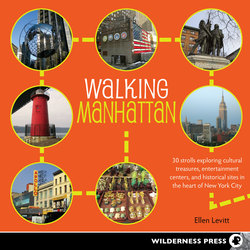Читать книгу Walking Manhattan - Ellen Levitt - Страница 17
На сайте Литреса книга снята с продажи.
Оглавление8 EAST VILLAGE: CLUBS, COLLEGE, CULTURE
BOUNDARIES: E. Houston St., Ave. A, E. 10th St., 3rd Ave.
DISTANCE: 4.2 miles
SUBWAY: F train to 2nd Ave.
The East Village is somewhat quieter, somewhat grittier, and somewhat less known than the Washington Square area, or even the West Village. But this is a neighborhood with a great deal of charm, considerable historical importance, cultural choices (and ghosts), and other C’s: cinema, cemeteries, Cooper Union, and churches.
The East Village draws young and old alike with its varied offerings of music, theater, dance, ethnic meals, fashion, and knickknacks. There are sweet little parks and stirring monuments. The northern segment has two historical anchors in the Cooper Union, a highly competitive college where presidential hopeful Abraham Lincoln spoke, and St. Mark’s Church-in-the-Bowery, Manhattan’s oldest place of continuous religious worship.
The East Village also has legendary places that are gone but still commemorated, such as punk-rock haven CBGB, the 2nd Ave Deli (which moved), Mars Bar, the Amato Opera, and others. A visit here is nostalgic at times, forward-thinking at others.
On March 26, 2015, the block of Second Avenue just south of St. Mark’s Place was rocked by a gas-line explosion and fire that killed 2 people, injured 22, and left more than 80 homeless. The blast leveled three buildings and badly damaged four others. In the true spirit of the city, area businesses, houses of worship, and nonprofits have stepped up to help the displaced.
Exit the subway on the First Avenue side. Just next to the station is First Park, a charming little sliver of a park and playground.
Make a left onto First Avenue and then a right on East First Street. Peretz Square, a long, thin triangle of a park, is to your right. At #108 is a brick building that used to be a synagogue and a performance space and is currently pricey residences.
BACK STORY: HILLY’S PLACE
CBGB stands among the most notorious, iconic, and influential rock-and-roll venues in the United States. Along with places such as Whisky a Go Go (West Hollywood) and the Fillmore and Fillmore West (San Francisco), CBGB—which actually stood for “Country Blue Grass Blues” but rarely staged such acts—is a shorthand for live music, especially punk and new wave. The club closed in October 2006 with a concert by Patti Smith, and its building has been added to the National Register of Historic Places. The address was 315 Bowery … and don’t you forget it.
None of this tells you much, though, about what it was like to attend a show there. I went to a number of shows at CBGB throughout the 1980s and some in the 1990s, and although it was usually fun, it was also crowded, loud, reeking of beer and sweat, and a sea of elbows. It also had remarkably disgusting bathrooms (which have been preserved and displayed at, among other places, the Metropolitan Museum of Art).
Almost every time I ventured into “CB’s,” the owner was at or near the door. Hilly Kristal was a gruff, disheveled guy who looked like someone’s dad who wandered into the wrong place. His eyeglasses were at the tip of his nose, and he was usually involved in paperwork or talking with someone. He watched over the place like a hawk.
In July 1999, I exhibited black-and-white photographs at the adjoining CB’s 313 gallery (313 Bowery) with a few other photographers, and while I was hanging up my framed prints, Hilly stood a few feet away from me, sawing away at wood planks. I’m not sure what he was working on at the time, but every once in a while he would let out a big sigh. I asked him about it and he gave an exaggerated shoulder shrug, just like my father would.
The first show I recall seeing at CBGB was The Dickies, a punk band that specialized in wacky, rapid-fire covers of mainstream rock and pop songs. Amid the proceedings, in walked actor Matt Dillon. My friend Antoinette approached him and said, “You’re rich, give me some money.” He handed her a dollar.
Who else did I see perform? I remember some names—the NiteCaps, Richard Hell, Token Entry, Murphy’s Law—plus assorted punk bands at the Sunday-afternoon “hardcore matinees,” a string of garage-rock bands, and others I just don’t recall. It was always an experience, even if the ladies’ room was as nasty as the men’s.
